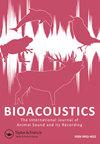Breeding phenology and behaviour of the Endangered Hewitt’s ghost frog Heleophryne hewitti in the Baviaanskloof World Heritage Site, Eastern Cape Province, South Africa
IF 2.1
4区 生物学
Q2 ZOOLOGY
Bioacoustics-The International Journal of Animal Sound and Its Recording
Pub Date : 2023-03-30
DOI:10.1080/09524622.2023.2193815
引用次数: 1
Abstract
ABSTRACT Given the potential impact of climate change on amphibians, there is a need to establish baseline phenological data for vulnerable species and to investigate their responses to changing climatic conditions. We recorded vocalisations of Hewitt’s ghost frog Heleophryne hewitti in the Baviaanskloof World Heritage Site, South Africa, to investigate its breeding phenology and vocalisation behaviour. Our objectives were to: 1) characterise seasonal and diel vocalisation patterns, 2) examine relationships between environmental variables and calling behaviour and 3) evaluate the effectiveness of acoustic recording as a monitoring technique. We employed automatic vocalisation recognition software to detect calls and used hurdle regression to model the relationships between environmental variables and the number of calls produced. Our study confirmed that H. hewitti is a seasonal prolonged breeder, with reproductive activity occurring from early to late spring. We found that while relative humidity seemed to influence the probability of calling, none of the weather variables appeared to have a strong influence on the number of calls produced. Acoustic monitoring combined with automatic vocalisation recognition has proven to be a viable technique for monitoring this species. Further investigation of cues for breeding initiation is required to understand the impacts of climate change on this species.南非东开普省Baviaanskloof世界遗产地濒危休伊特鬼蛙Heleophryne hewitti的繁殖物候和行为
摘要考虑到气候变化对两栖动物的潜在影响,有必要为脆弱物种建立基线酚学数据,并调查它们对气候条件变化的反应。我们在南非Baviaanskloof世界遗产地记录了休伊特的鬼蛙Heleophryne hewitti的叫声,以研究其繁殖表型和发声行为。我们的目标是:1)表征季节性和昼夜发声模式,2)研究环境变量和呼叫行为之间的关系,3)评估录音作为一种监测技术的有效性。我们使用自动发声识别软件来检测呼叫,并使用障碍回归来建模环境变量与产生的呼叫数量之间的关系。我们的研究证实,H.hewitti是一种季节性延长的饲养员,繁殖活动发生在早春至晚春。我们发现,虽然相对湿度似乎会影响通话的概率,但似乎没有任何天气变量对通话次数有很大影响。声学监测与自动发声识别相结合已被证明是监测该物种的可行技术。需要对繁殖开始的线索进行进一步调查,以了解气候变化对该物种的影响。
本文章由计算机程序翻译,如有差异,请以英文原文为准。
求助全文
约1分钟内获得全文
求助全文
来源期刊
CiteScore
4.50
自引率
0.00%
发文量
25
审稿时长
>12 weeks
期刊介绍:
Bioacoustics primarily publishes high-quality original research papers and reviews on sound communication in birds, mammals, amphibians, reptiles, fish, insects and other invertebrates, including the following topics :
-Communication and related behaviour-
Sound production-
Hearing-
Ontogeny and learning-
Bioacoustics in taxonomy and systematics-
Impacts of noise-
Bioacoustics in environmental monitoring-
Identification techniques and applications-
Recording and analysis-
Equipment and techniques-
Ultrasound and infrasound-
Underwater sound-
Bioacoustical sound structures, patterns, variation and repertoires

 求助内容:
求助内容: 应助结果提醒方式:
应助结果提醒方式:


